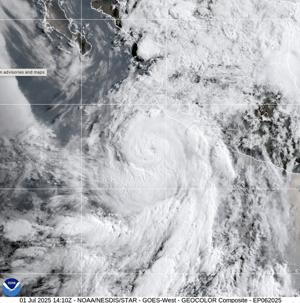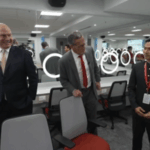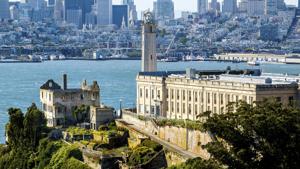TALLAHASSEE, Fla. — President Donald Trump toured a newly constructed immigration detention center in the Florida Everglades on Tuesday, a facility that has sparked heated debate among state officials and activists. This center, described by critics as an inhumane makeshift prison camp, is being hailed by supporters as a national model for intensifying detention and deportation efforts.
Accompanied by Department of Homeland Security Secretary Kristi Noem, Trump praised the facility, which is set to welcome its first detainees on Wednesday. The center currently has the capacity to house 3,000 individuals, with plans to expand to accommodate up to 5,000. Constructed rapidly by Florida officials, the compound features heavy-duty tents, trailers, and temporary buildings, all encircled by chain-link fences topped with barbed wire. The estimated annual cost of the facility is $450 million, funded by Florida and reimbursed by the Federal Emergency Management Agency.
Political and Environmental Concerns
Dubbed “Alligator Alcatraz” by state officials, the facility is strategically located at an isolated airfield approximately 45 miles west of downtown Miami. Surrounded by the challenging terrain of the Everglades, the location is intended as a deterrent, echoing the notoriety of Alcatraz, the infamous federal prison known for its harsh conditions. This move is part of a broader strategy by the Trump administration and its allies to use scare tactics to encourage voluntary departure of undocumented immigrants.
However, the decision to place the facility in such a sensitive ecological area has drawn significant backlash. Environmentalists and immigrant advocates have criticized the project as a threat to the Everglades’ delicate ecosystem. Protests have erupted, with demonstrators voicing concerns over potential damage to the wetlands and disruption to the traditional lands of the Miccosukee and Seminole tribes.
Trump’s Visit and Political Implications
Trump’s visit to the detention center underscored the significance of immigration as a unifying issue within the state’s GOP. The event brought together prominent political figures, including Florida Governor Ron DeSantis and GOP Representative Byron Donalds. Despite previous political tensions, Trump commended DeSantis, highlighting the site as a potential model for other states. “We’re surrounded by miles of treacherous swampland and the only way out is, really, deportation,” Trump remarked.
Outside the facility, protests continued, with environmentalists and immigrant rights groups decrying what they perceive as a political stunt. Simultaneously, supporters, including former Proud Boys leader Enrique Tarrio, gathered to back the initiative. The center is seen as crucial to supporting Trump’s mass deportation agenda, which has resulted in a record high of over 56,000 immigrant detentions in June, the most since 2019.
Legal and Regulatory Challenges
The construction of the detention center has not been without controversy. Florida officials utilized emergency powers, invoking an executive order from the DeSantis administration, to expedite the project. This maneuver has been criticized as an abuse of power, allowing the state to bypass standard regulations and legal constraints.
“Governor DeSantis has insisted that the state of Florida, under his leadership, will facilitate the federal government in enforcing immigration law,” a spokesperson for DeSantis stated. “Florida will continue to lead on immigration enforcement.”
Meanwhile, lawsuits have been filed by environmental groups such as the Center for Biological Diversity and the Friends of the Everglades, aiming to halt the detention center’s development due to environmental concerns.
Federal and State Collaboration
DHS Secretary Kristi Noem has expressed strong support for the facility, emphasizing the partnership between the federal government and Florida. The center is part of a broader federal initiative to expand detention capacity, with plans to increase the number of beds for detained migrants from the current 41,000 to at least 100,000.
The U.S. House of Representatives recently approved a tax-cutting and budget reconciliation bill that includes $45 billion over four years for immigrant detention, marking a threefold increase in spending.
As the Senate considers this legislation, the facility is poised to play a critical role in housing immigrants arrested under the federal 287(g) program and those in ICE custody.
The controversy surrounding the Florida detention center highlights the ongoing national debate over immigration policy, environmental conservation, and the ethical implications of detention practices. As the situation unfolds, the facility’s impact on both the local ecosystem and the broader political landscape remains to be seen.
About The Author
 Senate Approves Trump’s Comprehensive Domestic Policy Bill
Senate Approves Trump’s Comprehensive Domestic Policy Bill Wall Street Divided as Tesla and Tech Stocks Tumble Amid Broader Gains
Wall Street Divided as Tesla and Tech Stocks Tumble Amid Broader Gains Hurricane Flossie Threatens Mexico as It Nears Major Status
Hurricane Flossie Threatens Mexico as It Nears Major Status Federal Scrutiny on Hollywood’s Diversity Quotas for Oscars Intensifies
Federal Scrutiny on Hollywood’s Diversity Quotas for Oscars Intensifies Air India CEO Unveils State-of-the-Art Training Facilities to CNN’s Richard Quest
Air India CEO Unveils State-of-the-Art Training Facilities to CNN’s Richard Quest